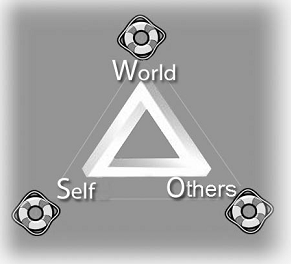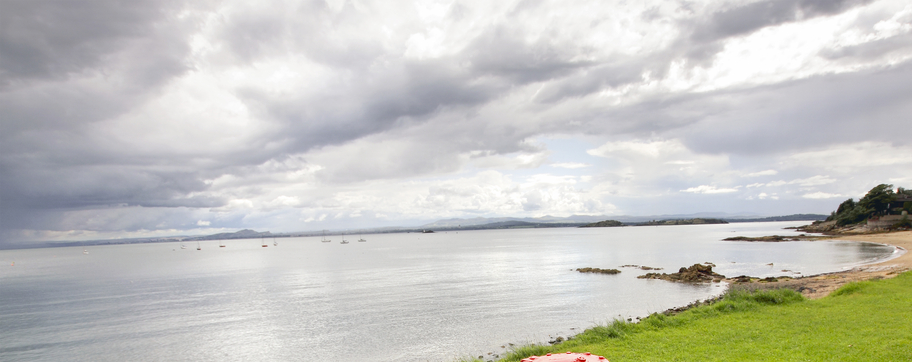Chaos and Change
All human experience is defined by the fluid nature of human experience. The Tidal Model borrows from chaos theory in recognising that all change, growth or development occurs through small, often barely visible changes, which follow patterns that are ã¢paradoxically - consistent in their unpredictability. The fluid nature of life itself provides the basis for the core metaphor of the Tidal Model 㢠water.
It is clear that, however many efforts we might make to control our lives, ultimately we are powerless to control everything that might happen to us. From the moment we flow out into the world, leaving the safety of the waters of our mother's womb, we face challenges - day in and day out. Many of us will make plans for the future, However, We cannot plan for every eventuality. Life will always surprise us. We need to learn to live with uncertainty. We need (metaphorically) to learn to swim with the tides or build a boat!
At the centre of all this flux lies the person. It is appropriate, therefore, that theoretical framework of the Tidal Model is built around that person.
A Model of the Person
 In
the Tidal Model
the person is represented by three personal domains: Self,
World and Others. A domain
is a sphere of control or influence: a place where the person
experiences or acts out aspects of private or public
life. A domain is a place where someone lives.
In
the Tidal Model
the person is represented by three personal domains: Self,
World and Others. A domain
is a sphere of control or influence: a place where the person
experiences or acts out aspects of private or public
life. A domain is a place where someone lives.
The
domains are like the personãs home address. The home may have
several rooms, but the person is not to be found in each of these
rooms at the same time. The Tidal domains are similar. Sometimes the
person is to be found in the Self domain, and at other
times is in the World or Others domains.
1. The Self Domain is the
person's private place. Here the person experiences thoughts,
feelings, beliefs, values, ideas etc, which are known only to the
person. In this private world the distress or difficulty of problems
in living are first experienced. All people keep much of their
private world secret, only revealing to others what they wish them
to know. This is why people are often such a ãmysteryã¢to us, even
when close friends or relatives.
In the Tidal Model
the Self Domain becomes the focus of our attempts
to help the person feel more ãsafe and secure㢠Here, we try to help
the person address and begin to deal with private fears, anxieties
and other threats to emotional stability, which may be related to
specific problems of living. The main focus is to develop a
ãbridgingã¢relationship (see Bridging) and to help the person develop a meaningful
Personal Security Plan. This work becomes the basis
of the development of the personãs ideas about how to sustain
themselves on return to everyday life.
2.
The World Domain is the place where the person
shares some of the experiences from the Self domain, with other
people. When people talk to others about their private thoughts,
feelings, beliefs or other experiences known only to them, they
enter the World Domain.
In the Tidal
Model the World Domain becomes the focus
of our efforts to understand the person and their problems of
living. This is done through use of the Holistic Assessment
. At the World Domain we also try to help the
person to begin to identify and address specific problems of living,
on an everyday basis. This is done through use of dedicated
One-to-One Sessions.
3. The
Others Domain is the place where the person acts out
everyday life with other peopleãfamily, friends, neighbours, work
colleagues, professionals etc. Here the person engages in
interpersonal and social encounters, within which they may be
influenced by others, and may,in turn,influence others.
The
organisation and delivery of professional care and other forms of
support is located in the Others Domain. However,
the key focus of the Tidal Model is on three
dedicated forms of group workã¢em>Discovery,
Information-Sharing and Solution-finding .
By
participating in these groups, the person develops awareness of the
value of social support, which can be received from and given to
others. This becomes the basis of the personãs appreciation of the
value of mutual support, which can be accessed in everyday life.
All Change is Ephemeral
In Tidal we accept that change is inevitable.
Nothing lasts! Neither our misery, nor our joy. The fickle, fleeting
nature of human experience is what makes it so special. The pain of
emotional distress only feels as if it is unceasing.The euphoria of
happiness deceives us into thinking that it is anything more than
'momentary'. But, nothing lasts. If only we could hang on to this
enduring wisdom, we might begin to live in, and for, the moment.
Even change itself is momentary - and does not last.
The Uniqueness of Human Experience
In the Tidal
Model
we recognise that we can never know another person's experience. Joy or pain, exhiliration or
melancholy, must be experienced, to be fully understood. We may, of
course, share names for such experiences.
However, I can never be certain that my 'joy' is exactly the same as
your 'joy'. We all are as unique as our fingerprints.
(See The 10 Commitments)
The nearest we ever get to 'knowing' another person's experience is
through empathy - where we try to connect, as much as we
are able, or as much as we dare , with the experience of another. We
try to
feel what they appear to be feeling; to think what they are
thinking. To say that this is difficult is an understatement.
As the Irish-American psychiatrist, Harry Stack Sullivan said: "We are all much more simply
human than otherwise, be we happy and successful, contented and
detached, miserable and mentally disordered, or whatever.'(Conceptions
of Modern Psychiatry).
As persons, we have much in common. That
said, there is much that we can learn about ourselves by
trying to learn something about the experiences of others.
The Metaphor of Change
The Tidal Model acknowledges that all human experience is fluid, rather than stable. Experiences flow through us. They may leave behind some trace, memory or emotional imprint, but the experience has moved on. It could not do otherwise. The idea that we could stand still is an illusion. Even if we do not move (physically) time passes through us; we age and all manner of invisible changes occur within our physical and psychological selves. This happens whether we want this or not.
None of this is new - but it is worth reminding ourselves that there are few 'new' ideas - if any - about human life and relationships.
The Tidal Model assumes that the only
constant is the personal experience of change. This is hardly a new
perspective on human affairs. As Euripides observed - two
and a half thousand years ago:
"All is change; all yields its place and goes".
His contemporary,
Heraclitus was also was aware of the impermanence of the world, as well
as our place within it.
"Nothing is permanent but change....No
man ever steps in the same river twice, for it's not the same river
and he's not the same man"
Everyday human experience is change, change, and yet more
change. People change, often like nature or the the seasons, which
grows itself from the leftovers of past. People often seem to do
likewise, using the relics of their past, to generate new futures.
Here lies our hopes of reclamation, regeneration and
recovery.
People can, and very often do, resist
change, which often appears to bring many threats in its wake. As
Andre Gide remarked,:
"Loyalty to the past stops us seeing
that tomorrow's joy will come only if today makes way for
it".
The Tidal Model is focused on change
but
recognises that change is not just a metaphor. It also is impermanent.
Nothing lasts! This
leads us to ask people how they experience change. To help people
develop their awareness of the changes going on within
them - and around them - we need to be curious about the nature of change itself.
How
do people change? What is happening within them, around them, and
especially in their relationships with the world of others?
The Tidal Model acknowledges the critical importance of metaphor,
both as the means of framing experience, but also for establishing
what might ultimately be called regeneration or recovery. One of the
key metaphors in the Tidal Model is the idea of 'rescue'. When people experience their greatest human crises they
need a special kind of 'lifesaver' - someone who will help pull them
from the myriad threats inherent in their present situation.
However, this is only one, important stage, in the Tidal process.
After the 'rescue' comes the detailed examination of how the person
came to find themselves in such threatening conditions and, more
importantly, what needs to happen NOW ?
Learning from Reality
Many of us live
our lives as if our words had a strange power to change things.
In truth, reality just is. Ultimately
we come to the realization that we can no more change ourselves by
changing the words we use than we can change our handwriting by
changing pens. The story of our lives is really within us.
Any
change will come from within; it will be an educational experience,
as we 'draw out from within' the reality of our circumstances.
As we become more
aware of ourselves and our circumstances we develop
ãinsight㢠We understand ourselves - and perhaps life - better.
Regrettably, psychiatric professionals talk too much about insight ã¢often pretending to know whether or not people
(patients) have become more insightful about themselves and their
lives. We can never know another person's experience - and that
extends to what we might call 'insight'. In the Tidal Model
we recognise that the person is (indeed must be)
the expert on her or his life. We, whether family, friends or
helping professionals, are mere bystanders in that person's life.
However, by talking about their experiences people begin to notice
'change'. They begin to realise that the story of 'who' they are,
'what' has happened to them and what they have done by way of
response is not a static
thing. It is not fixed but is in flow.
In the Tidal Model we recognise that people are not static; they are not fixed, far less rooted to the spot. They are living and growing, moment by moment. When they talk about themselves and their experiences, they make themselves up as they talk. As a result, the simple act of talking about our experience can change 'who' and 'what' we are.
All the work we do
with the person is done in the hope that at some point the person
will become aware of this too - and nothing will ever be quite the
same again.






